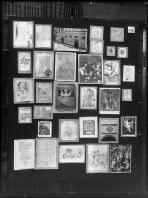Approaching Fortuna
The panel begins with book illustrations of both manuscripts and early prints, underscoring the popularity that Fortuna had regained for late medieval authors. Christine de Pizan’s “L’Epistre d’Othea” (#1) depicts Fortuna detached from the fate she gives to the ones tied to her wheel; she is still the inaccessible “domina” as Boethius had described her in the 6th century. A Boethius illustration (#3) depicts her face hidden behind two long strands of hair, which ambiguously point in opposite directions. Also the 1424 depiction (#4) from a manuscript reinterpreting various pagan gods is in line with this fateful Fortuna; by quoting Boethius it claims she is “postior alba … antior nigra” (white on the front, black on the rear) and shows her accordingly with two faces gazing in opposite directions. Three illustrations from works by Boccaccio (#5, 6, 8) carry us into the print age and continue to play with Fortuna’s antagonistic forces – here with an increasing focus on ethically oriented narratives. Especially striking is the quasi-syllogistic, three-step illustration (#6) of a fable, from the prologue to book three of Boccaccio’s “De casibus virorum illustrium,” that pits orthodox faith against astrological fate. Here we see how Poverty’s belief in her own luck causes a defeat for Fortuna (#6 bottom), who in turn has to agree to tie Misfortune to a tree (#6 top). This battle of Poverty and Fortuna marks a decisive shift, since it takes the initiative of coming in contact with Fortuna away from her and gives it to those who approach her. Her effects on human existence can now be altered, she becomes a vision with whom one interacts. This first sequence thus ends with the dream Pope Pius II had about Fortuna (#7), in which he had to approach her (!) in her enclosed garden in order to learn how to understand the people’s fortunes and misfortunes in a manner favorable to his papal reign.
Iconologically the sequence remains medieval and indebted to Boethius, as it portrays Fortuna as a female controlling the wheel on which the fortunes of all members of society turn. It does not yet show any reference to the long forelock designating the Greek goddess Kairos (#22), nor to the ships or sails found in Hadrian’s 2nd-century Isis Pelagia coin (#10) – two significations which will figure in the later images in the panel.
The fact that this first sequence is comprised of book illustrations underscores the strong affinity between the semantic fields of Fortuna and the imaginary, hermeneutic operations both texts and pictures require. This foreshadows that Fortuna will become one of the dominant figures of the humanistic age and explains the vernacular admiration she received in the following centuries, which becomes increasingly symbolic and emblematic, as the next sequences will show.
